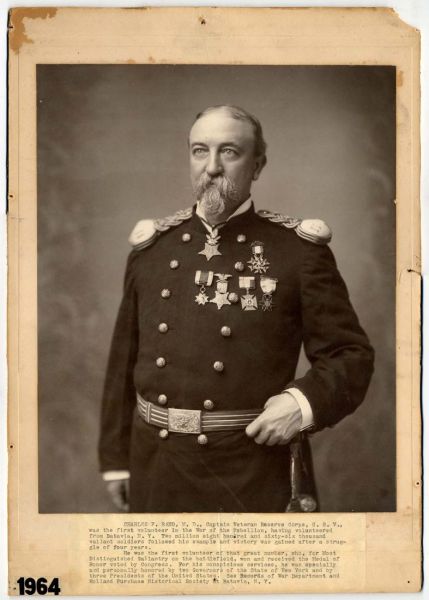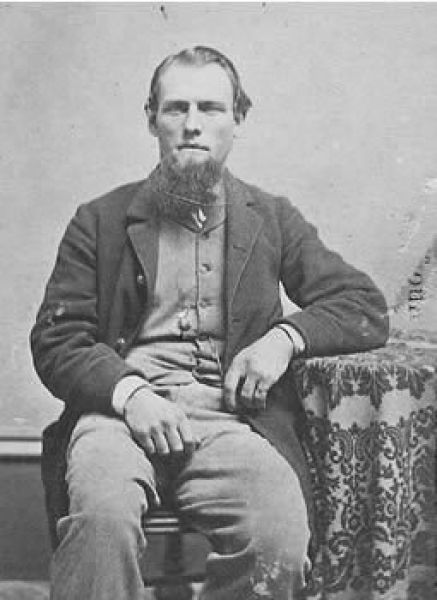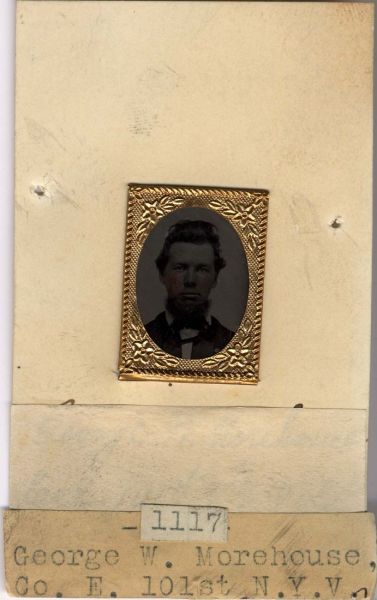101st Infantry Regiment
Nickname: Union Brigade; Second Onondaga County Regiment.
Mustered in: September 2, 1861 to February 28, 1862
Transferred to 37th regiment of infantry: December 24, 1862
The following is taken from New York in the War of the Rebellion, 3rd ed. Frederick Phisterer. Albany: J. B. Lyon Company, 1912.
Johnson Butler Brown was authorized in September, 1861, to recruit a regiment of infantry with headquarters at Syracuse, the 2d Onondaga County Regiment. Enrico Fardella was authorized to recruit a regiment of infantry with headquarters at Hancock, the 1st Union Brigade. The organization of these regiments making slow progress, they were ordered in January, 1862, to be consolidated into one regiment with Enrico Fardella as Colonel and Johnson Butler Brown as Lieutenant-Colonel, and the fraction of the regiment organized at Syracuse was ordered to Hancock in February, 1862. The 1st Union Brigade consisted of Companies A, B, C, D, E, F and G, in January, 1862. On the 28th of January Companies F and G were consolidated to form Company F; this company became, February 7, 1862, Company E, that company having been consolidated with Companies B and C. This new Company E was at the consolidation of the Hancock and Syracuse regiments merged into Companies A, B, C and D, and a new Company E formed. The companies of the Union Brigade formed respectively Companies A, D, F, G and K of the 101st Infantry.
The 2d Onondaga County Regiment was in February, 1862, formed, by consolidations, into five companies, which became Companies B, C, E, H and I of the 101st Infantry.
The regiment was mustered in the service of the United States for three years between September 2, 1861, and February 28, 1862. The companies were recruited principally: A at New York City; B, H and K at Syracuse; C at Conestoga; D, F and G at Hancock; E at Utica, and I at Camillus.
The regiment left the State March 9, 1862; served in General Wadsworth's command, Military District of Washington, from March, 1862; in Whipple's Brigade, Military District of Washington, from May, 1862; in 2d Brigade, 3d Division, 3d Corps, Army of the Potomac, from June 9, 1862; in 2d Brigade, 1st Division, 3d Corps, Army of the Potomac, from July, 1862; in 3d Brigade, 1st Division, 3d Corps, Army of the Potomac, from November 14, 1862, and December 24, 1862, under Col. George F. Chester, it was transferred to the 37th N. Y. Volunteers and discontinued.
During its service the regiment lost by death, kill in action, 13 enlisted men; of wounds received in action, 1 officer, 12 enlisted men; of disease and other causes, I officer, 48 enlisted men; total, 2 officers, 73 enlisted men; aggregate, 75; of whom 1 enlisted man died in the hands of the enemy.
The following is taken from The Union army: a history of military affairs in the loyal states, 1861-65 -- records of the regiments in the Union army -- cyclopedia of battles -- memoirs of commanders and soldiers. Madison, WI: Federal Pub. Co., 1908. volume II.
One Hundred and First Infantry.—Cols., Enrico Fardella, George F. Chester; Lieut-Cols., Johnson B. Brown, Gustavus Sniper; Majs., Gustavus Sniper, Samuel L. Mitchell. This regiment, known as the Union brigade or Onondaga regiment, was organized at Hancock, Jan. 3, 1862, was recruited in the counties of Delaware, New York and Onondaga, and was mustered in from Sept. 2, 1861, to Feb. 28, 1862. It left the state for Washington March 9, 1862, and in June was assigned to Kearny's famous division, 3d corps, with which it took part in the Seven Days' battles, fighting at Oak Grove, Glen-dale, and Malvern hill, with a loss during the campaign of 7 killed; 15 wounded and 22 missing. On Aug. 14, the regiment marched with the 3d corps to Yorktown, whence it embarked for Alexandria, and proceeded from there to Warrenton Junction, where it was pent to reinforce Gen. Pope. It was engaged at Groveton, the second Bull Run and Chantilly, sustaining a loss at Bull Run of 6 killed, 101 wounded, and 17 missing, a total of 124 out of 168 en-gaged, or over 73 per cent.—a percentage only exceeded in any one battle by two other regiments in the Union Army. It was active at the battle of Fredericksburg in December, losing 13 killed and wounded. On Dec. 24, 1862, it was transferred to the 37th N. Y. infantry and the officers were mustered out. The regiment lost during service I officer and 25 enlisted men killed and mortally wounded; I officer and 48 enlisted men died of disease and other causes; total, 2 officers and 73 enlisted men.
NYSMM Online Resources
Battles and Casualties from Phisterer (pdf)
Battles and Casualties from Phisterer (spreadsheet)
Civil War Newspaper Clippings (text)
Pages 1 - 2 (pdf)
Miscellaneous documents (Collection 2012.0055, originally found in the 101st Infantry newspaper folder) (text)
Page image view is here. (pdf)




